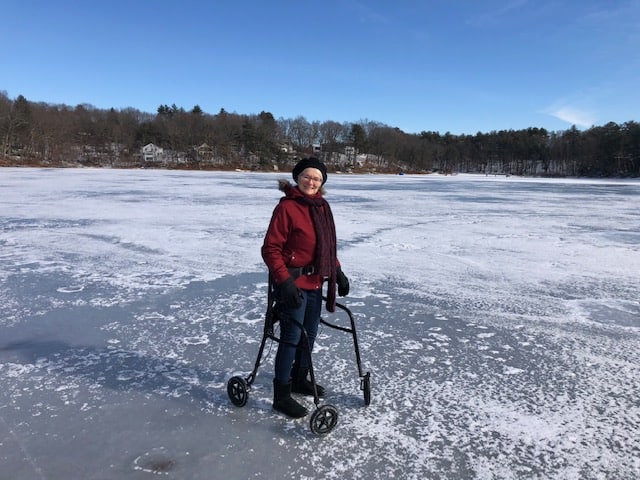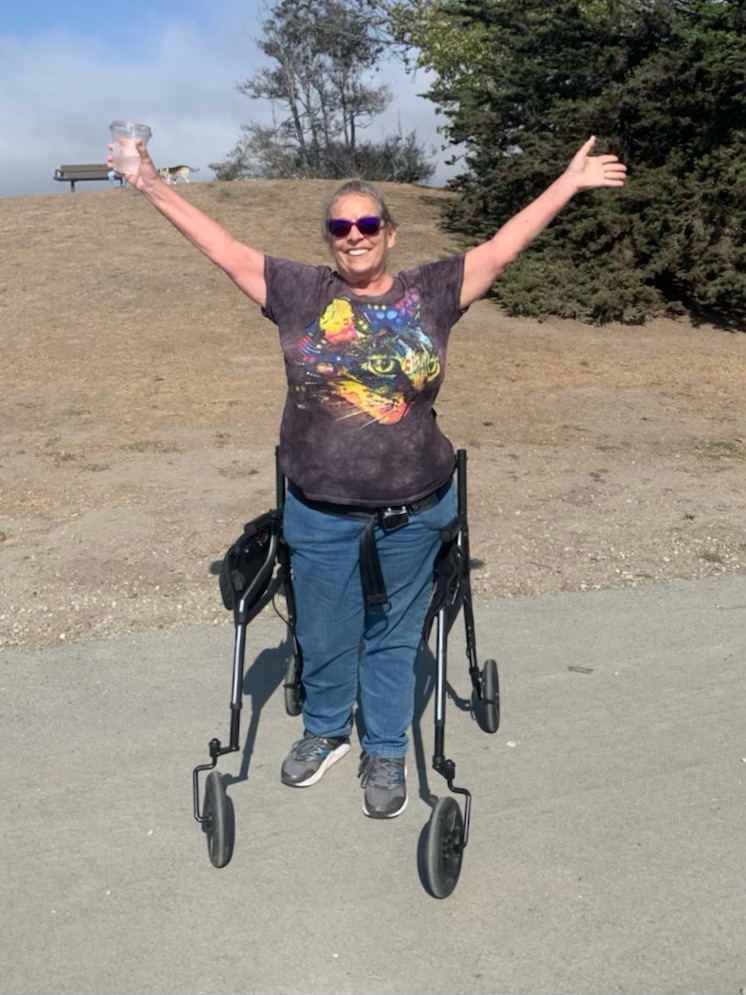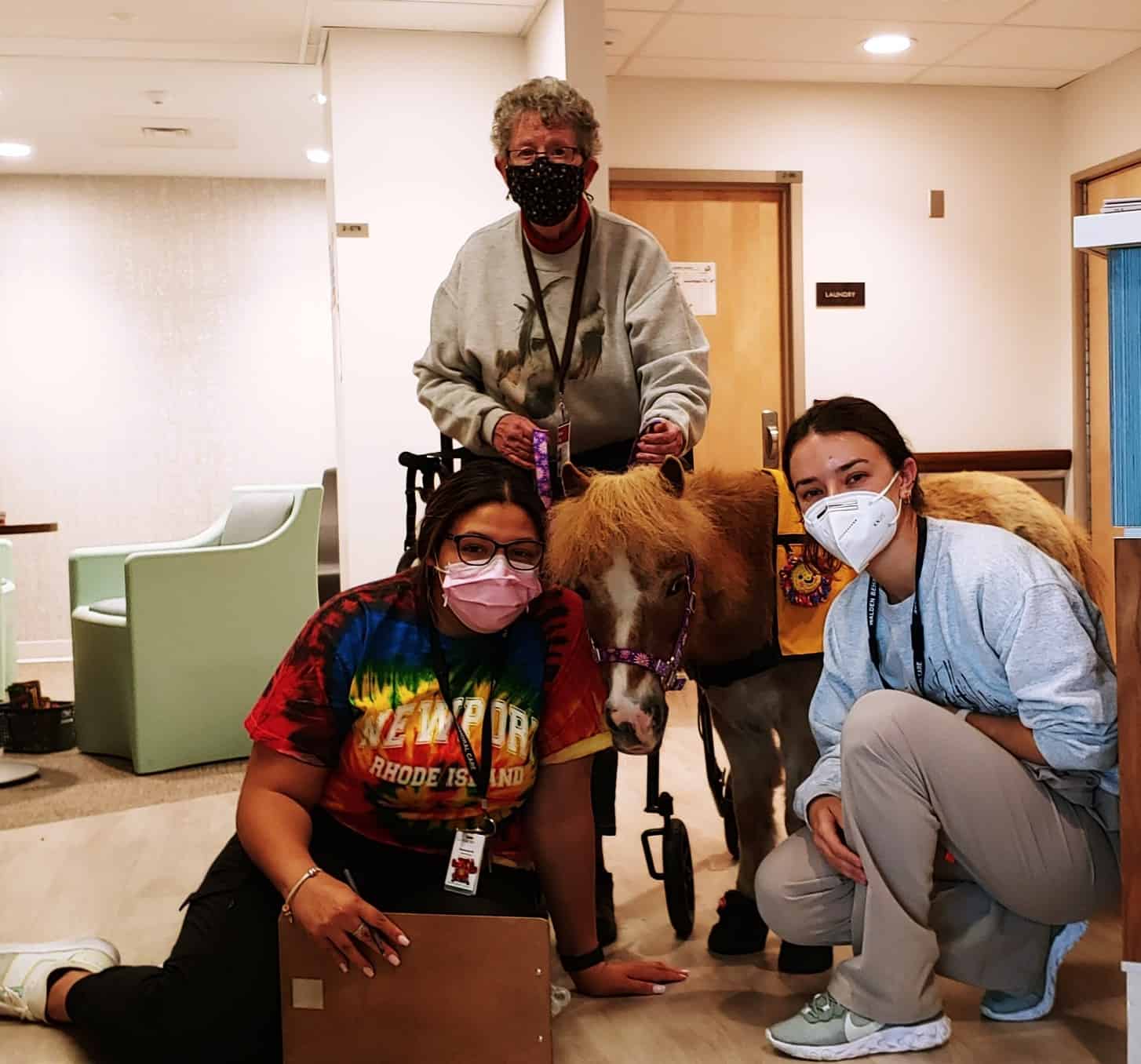I grew up on a lake in Massachusetts. Naturally, I’ve always loved swimming and kayaking in the summer, ice skating in winter. Just being near the water. But I have missed being able to enjoy winter activities since the onset of my disease a decade ago.
Three years ago, I moved to a house on a pond here in Concord. Summers are great. I can swim and kayak from my own backyard and dock. But in winter, even though I enjoyed watching the skaters, skiers, and people ice fishing from my window, it deepened my sense of loss being able to watch but not join them.
I had already lost so much. Prior to developing my autoimmune disease in my late 50s, I enjoyed my work in public health research and community social work. But starting in 2010, I found myself feeling a level of fatigue that was the most profound I’d ever felt in my life. There was no reason for it. It wasn’t for lack of sleep or because I’d done something taxing.
At the same time, there was this feeling as if I’d just come off a sailboat. Like I was rocking back and forth when I wasn’t. It began to interrupt the way I would cross a room. The rocking sensation would be so strong, I would be touching objects just to steady myself.
I sought medical care. At first, it seemed no amount of testing would show what was wrong. I kind of started to think I was going crazy. I took time off of work to see if I could rest my way through it.
It didn’t work. I ended up having to give up my job. Today, I’m an active volunteer as a member of the Town of Concord Disability Commission, and as a baby cuddler in the special care nursery at Massachusetts General Hospital, comforting newborns. But at the time, it was difficult to leave full-time work. It was part of my identity.
An Uncommon Presentation of Sjogren’s Syndrome
I had developed a pronounced tremor in my right hand and arm and an uncontrollable jerking motion in my shoulder. I couldn’t hold my head up at times, like a baby who hasn’t developed head control yet. I had double-vision. It was miserable, but at least the doctors could more clearly see now that something was wrong.
It was enough for an initial diagnosis. For months, I was treated for Hashimoto’s encephalopathy. I was exposed to high doses of steroids, in the form of prednisone. This was necessary for treatment but resulted in bone loss and avascular necrosis, resulting in my needing a hip replacement recently, all these years later.
When new symptoms appeared, suggesting I had been misdiagnosed, testing began all over again. After another exhausting round of lumbar punctures, pet scans, MRIs and neural biopsies, they changed my diagnosis to Sjogren’s encephalopathy, an uncommon presentation of the autoimmune disorder Sjogren’s syndrome.
The good news was they now knew how to treat it with a chemotherapy drug targeted to the specific antibodies that were harming me. I began to get better, but there were lasting effects on my balance and mobility. I was left with ataxia, mostly in my trunk, making standing or walking possible for only short periods of time and distance. This is why I use a wheelchair.
It’s not that I can’t use my legs. I can rise to my feet, stay up long enough to make a cup of tea and a simple breakfast, but then I start to stagger and have to sit back down.
Thankfully, I can still swim. I can still go kayaking. But what I really missed with the wheelchair were the winter activities I used to enjoy. I love ice skating, cross-country skiing, and just walking out on the lake to watch the sunset or talk to the fishermen. It’s difficult to maneuver on the ice with a wheelchair.
With the LifeGlider, it’s a different story.
Life with My LifeGlider vs. the Wheelchair
A perfect stranger recommended it to me. I was in the shop where they service my accessible van, and another customer who was waiting, a woman, saw me stagger to the bathroom and back. She saw that I could walk, but had a balance problem, and told me the LifeGlider would be perfect for me. I went online and ordered it right away.
I’m now in my second winter with the LifeGlider, and I’m still learning what I can do with it. I’ve discovered it’s much easier to be out on the ice because you can use your legs and boots to get traction and steer yourself, even when there’s a thin layer of snow. Also, just the experience of moving across the ice in a standing position is more satisfying. That’s all I did at first, was walk. But then I got the idea to use ski poles. My next time out I discovered I could push myself with the poles and glide over the ice, similar to cross-country skiing!https://vimeo.com/520780000
It makes life easier in a number of ways. For one thing, I can’t get onto the lake near my house in the wheelchair. I used to have to drive down to the boat launch, take out my wheelchair and enter the lake from there. Now, my husband can easily fold up the LifeGlider, meet me at the bottom of the chair lift that gets me down the hill, and with it, I can walk straight onto the ice just as you would walk into your backyard.
It’s a relief to be able to be upright and hands-free. I’ve had a lot less back pain because I’m standing more. And I can give my hands a break from the abuse they get from gripping the rims of my wheelchair. The hands-free part is great for doing chores, too. Though the wheels are a bit too far in front of me to comfortably reach and wash the dishes, I’ve found I can sidle up to the stove and turn my body long enough to cook.
It really helps in social situations, too. We live near a paved bike path that I take my recumbent bike on, or sometimes my wheelchair. Those are really solo activities because it’s so hard to talk to someone who’s standing, especially when you’re both wearing masks and they’re six feet away from you. With the LifeGlider, at least we’re both at the same height. It’s easier to talk and less awkward.
Another thing I’m eager to try after COVID, when people are getting together again, is to go to a cocktail party where people stand around to chat. It’s so awkward in a wheelchair. You’re always looking at people’s butts, for one thing. And once someone hands you a drink or a plate of food, your hands are no longer free, so you’re stuck where you are. I’m looking forward to being able to hold a drink, see somebody across the room and just walk over.
There are just so many other situations where it’s easier to get around with the LifeGlider than a wheelchair. I’ve also found I can move over gravel and stone paths more easily, like the kind they have at garden nurseries. And I can carry the plant instead of balancing it on my lap, getting dirt all over myself. Really, it’s great for any shopping application.
Yes, Your Spouse Could Use a LifeGlider
Whenever I talk to people who are interested in getting a LifeGlider – often for their spouses who have mobility problems, whether due to an injury or other mobility-limiting condition – I almost always tell them to do it.
Ironically, when I worked as a social worker it was with people with disabilities. Some of the patients I saw had found ways to live rich and meaningful lives in spite of their disability. They were great role models for me after I became disabled.
Now, I try to be a role model for others when I tell them about what they can do with the LifeGlider.
It’s wonderful for recovery. When I was in physical therapy after my hip replacement surgery, it was so difficult and painful to bear weight. With the support of the LifeGlider, I’m sure it helped me to get back on my feet sooner.
And it’s so useful in everyday life. I’m excited to share that I’m going to be a grandmother for the first time in April! So, I’ve signed up for occupational therapy to get some tips on how to safely care for an infant using both the wheelchair and my LifeGlider.
If you’re interested in this for a loved one, I will say don’t hesitate as long as they are cognitively aware and have good enough vision to not step off a curb or too steep a grade. You wouldn’t want people in a situation where they might go off a curb and get hurt.
But if your problem is mostly mobility in terms of your balance or strength, there’s no reason not to get a LifeGlider. In so many situations, it’s really great.
Come out on the ice with me sometime. I’d be delighted to show you!



